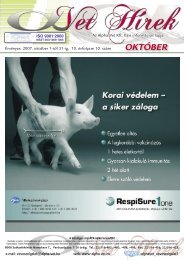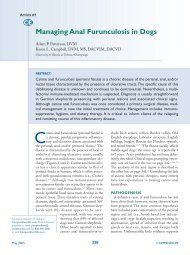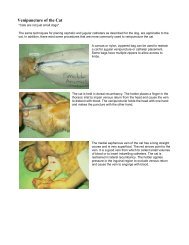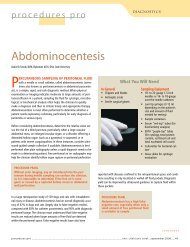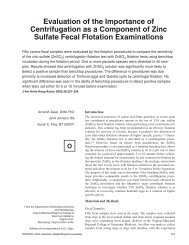Cephalic and Saphenous Vein Catheterization Page 1 ... - Hungarovet
Cephalic and Saphenous Vein Catheterization Page 1 ... - Hungarovet
Cephalic and Saphenous Vein Catheterization Page 1 ... - Hungarovet
You also want an ePaper? Increase the reach of your titles
YUMPU automatically turns print PDFs into web optimized ePapers that Google loves.
Placing a catheter in the cephalic or saphenous vein. Small Animal Diagnostic <strong>and</strong> Treat...http://courses.vetmed.wsu.edu/samdx/cephalic.asp<strong>Page</strong> 1 of 608-04-2008Techniques Homeaspiration massarthrocentesisbone marrowcatheter: butterflycatheter: cephaliccatheter: jugularcentral venouscystocentesisear examinjections: IMinjections: SCspinal fluidstomach tubethoracic drainthoracocentesisurinary cathetercat nasogastriccat urinary cathcat venipuncturePrinter Version<strong>Cephalic</strong> <strong>and</strong> <strong>Saphenous</strong> <strong>Vein</strong> <strong>Catheterization</strong> Search CVM GoAny of the catheters that canbe placed in the jugular veincan also be placed inperipheral veins. Shortcatheters sold for placementin peripheral veins such as(a) <strong>and</strong> (b), have the catheteron the outside of the needleso the hole in the vein wallmade by the needle issmaller than the catheter.The catheter fills the hole inthe vein wall <strong>and</strong> there isminimal leakage of bloodaround the catheter.c) is a butterfly catheter (no, butterflies are not free, they cost ~$2.00). The "catheter" portionthat goes in the vein is a rigid needle. Butterfly catheters are used for short term, smallvolume, infusions such as the administration of CaparsolateTM used to treat heartwormdisease.Because of its rigidity, it is not useful for long term fluid administration as the needle maylacerate the vein. (d) is a catheter that has the conformation of a butterfly catheter but thecatheter is flexible teflon rather than metal. The catheter has a wire stylet that is removed afterplacement. This style of catheter is very useful for placement in peripheral veins in small dogs<strong>and</strong> cats <strong>and</strong> breeds of dogs with short, crooked legs. It can also be used to drain fluid or airfrom body cavities. The flexibility of the catheter after the stylet is removed, reduces the chanceof organ laceration.Have all necessary supplies ready before placing the catheter. Supplies needed in addition tothe catheter include one inch tape, (2 pieces of sufficient length to encircle the limb), an injectioncap <strong>and</strong> a 10-12 ml syringe filled with saline or heparinized saline. If the catheter is to be left inplace for several days, a small amount of antiseptic or antibiotic ointment on a gauze pad shouldbe placed over the catheter puncture site before b<strong>and</strong>aging the catheter in place.The catheter placement site should be widely shaved <strong>and</strong> the skin scrubbed with antisepticsolutions, using the same technique as for preoperative skin preparation.Notice that the holder is st<strong>and</strong>ing on the side of thedog opposite the leg that is being catheterized. Thedog is restrained close to the body of the holder. Themuzzle is held away from the face of the holder <strong>and</strong>the person placing the catheter. She is reaching overthe dog to hold off the vein <strong>and</strong> can apply downwardpressure over the dog's back, if needed to keep thedog in sternal recumbancy. The dog's leg is being heldat the elbow to prevent her from pulling back her leg.
Placing a catheter in the cephalic or saphenous vein. Small Animal Diagnostic <strong>and</strong> Treat...http://courses.vetmed.wsu.edu/samdx/cephalic.asp<strong>Page</strong> 2 of 608-04-2008The individual holding the leg places the thumb of thesame h<strong>and</strong> across the dorsum of the limb to occludevenous blood returning from the leg, causing the veinto distend with blood. In some cases the vein will beclearly visable, in other cases you may palpate thedistended vein.The holder places her thumb firmly on the medial side of the most proximal aspect of thelimb. The thumb is "dragged" to the dorsal aspect of the leg which will "roll" the cephalic veinto the dorsum of the leg. Pressure is applied with the thumb to restrict blood flow returningfrom the distal limb, causing the vein to engorge with blood. The catheter should be placedas distal in the vein as possible. If the catheter is too proximal, its tip will lay at the elbow. Asthe animal withdraws its leg, flow through the catheter may cease. You can catheterize thecephalic vein on the medial side of the limb, at a location distal to the junction of the cephalic<strong>and</strong> accessory cephalic veins. Before making the puncture, the venipuncturist can lay thethumb of the h<strong>and</strong> that is holding the leg, adjacent to the vein to reduce vein movement when
Placing a catheter in the cephalic or saphenous vein. Small Animal Diagnostic <strong>and</strong> Treat...http://courses.vetmed.wsu.edu/samdx/cephalic.asp<strong>Page</strong> 4 of 608-04-2008Fold over the end of the tape to create atab for easier removal.A second piece of tape placed underthe cap will allow easier removal <strong>and</strong>replacement of the cap <strong>and</strong> preventhair from touching the tip of thecatheter.The injection cap can be removed for direct connection of a fluid administration set (a) to theIV catheter, or the cap can be left on the catheter <strong>and</strong> the fluid administration set attachedusing a 20 gauge hypodermic needle inserted through the cap. The administration set is"looped" <strong>and</strong> taped to the leg (b) . This reduces the chance of accidental removal of thecatheter if the administration set is pulled.
Placing a catheter in the cephalic or saphenous vein. Small Animal Diagnostic <strong>and</strong> Treat...http://courses.vetmed.wsu.edu/samdx/cephalic.asp<strong>Page</strong> 5 of 608-04-2008A hypodermic needle with plasticcover, attached to an injectioncap can be taped to the IV poleor the fluid bag or bottle. Whenfluids are temporarily stopped,the injection cap is placed on theend of the catheter <strong>and</strong> theneedle with plastic cover isplaced on the end of the IVadministration set to keep the tipof the tubing sterile.Movement of the leg can occlude fluidflow through the catheter. If needed, asplint such as the pictured Mason-metasplint can be used to keep the limbextended to maintain a constant fluidflow rate. The leg <strong>and</strong> splint can thenbe b<strong>and</strong>aged or the splint can be tapedto the leg at both ends, leaving thecatheter exposed. The use of IVinfusion pumps reduces the need tokeep the limb extended. Fluid pumpscan often overcome the resistancecreated by positional changes.<strong>Saphenous</strong> <strong>Vein</strong>
Placing a catheter in the cephalic or saphenous vein. Small Animal Diagnostic <strong>and</strong> Treat...http://courses.vetmed.wsu.edu/samdx/cephalic.asp<strong>Page</strong> 6 of 608-04-2008To place a catheter or obtain blood from the lateral saphenous vein, the animal is positioned inlateral recumbancy. The holder is holding off the vein with her right h<strong>and</strong>. Some dogs have aprominant medial saphenous vein which can be catheterized or sampled. To access the medialsaphenous vein, the animal is held in lateral recumbancy but the holder applies pressure on themedial aspect of the leg closest to the table. *The technique for placing a catheter in the lateralsaphenous vein of the dog is similar to the technique forcephalic placement. Notice the venipuncturist hasplaced her thumb adjacent to the vein to stabilize it.return to main menuRevised June 19, 2004 | Printer Friendly VersionContact us: webmaster@wsu.edu 509-335-9515 | Accessibility | Copyright | PoliciesCollege of Veterinary Medicine, PO Box 647010, Washington State University, Pullman, WA 99164-7010 USAEmergency Preparedness & Safety Links




